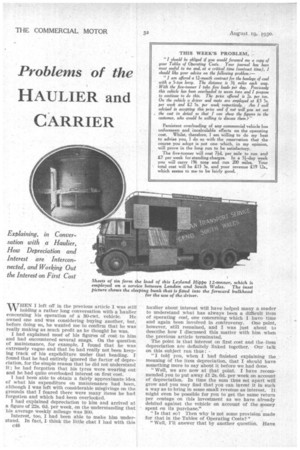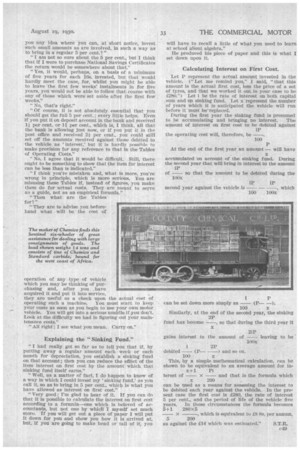Problems of the
Page 70

Page 71

If you've noticed an error in this article please click here to report it so we can fix it.
HAULIER and
CARRIER
Explaining, in Conversation with a Haulier, How Depreciation and Interest are Interconnected, and Working Out the Interest on First Cost
WHEN I left off in the previous article I was still holding a rather long conversation with a 'haulier
concerning his operation of a 30-cwt. vehicle. He owned one and was considering buying another, but, before doing so, he wanted me to confirm that he was really making as much profit as he thought he was.
I had explained most of his figures of cost to him and had encountered several snags. On the question of maintenance, for example, I found that he was extremely vague and that he had really not been keeping track of his expenditure under that heading. I found that he had entirely ignored the factor of depreciation, for the simple reason that he did not understand It; lie had forgotten that his tyres were wearing out and he had quite overlooked interest on first cost.
I had been able to obtain a fairly approximate idea of what his expenditure on maintenance had been, although I was left with considerable misgivings on the grounds that I feared there were many items he had forgotten and which had been overlooked.
I had explained depreciation to him and arrived at a figure of 22s. 6d. per week, on the understanding that his average weekly mileage was 300.
Interest, too, I had been able to make him understand. In fact, I think the little chat I had with this 018
haulier about interest will have helped many a reader to understand what has always been a difficult item of operating cost, one concerning which I have time and again been involved in controversy. One point, however, still remained, and I was just about to describe how I discussed this matter with him when the previous article terminated.
The point is that interest on first cost and the item depreciation are definitely linked together. Our talk on this subject ran thus :
"I told you, when I had finished explaining the meaning of the item depreciation, that I should have something more to say about it before we had done.
"Well, we are now at that point. I have recommended you to put away £1 2s. 6d. per week on account of depreciation. In time the sum thus set apart will grow and you may find that you can invest it in such a way as to bring in some small revenue as interest. It might even be possible for you to get the same return per centage on this investment as we have already debited against the vehicle on account of the money spent on its purchase."
"Is that so? Then why is not some provision made for that in the Tables of Operating Costs? "
"Well. I'll answer that by another question. Have you any idea where you can, at short notice, invest such small amounts as are involved, in such a way as to bring in a regular 5 per cent.?"
"I am not so sure about the 5 per cent., but I think that if I were to purchase National Savings Certificates the return would be somewhere about that."
"Yes, it would, perhaps, on a basis of a minimum of five years for each 16s. invested, but that would hardly meet the case, for, whilst you might be able to leave the first few weeks' instalments in for five years, you Would not be able to follow that course with any of those which were set aside after the first few weeks."
"No, that's right."
"Of course, it is not absolutely essential that you should get the full 5 per cent.; every little helps. Even if you put it on deposit account in the bank and received per cent., or la per cent., which is, I think, all that the bank is allowing just now, or if you put it in the post offiee and received 2i. per cent., you could still set off the amounts received against those debited to the vehicle as interest,' but it is hardly possible to make provision for any reference to that in the Tables of Operating Costs."
"No, I agree that it would be difficult: Still, there ought to be something to show that the item for interest can be less than is indicated."
"I think you're mistaken and, what is more, you're wrong in principle, which is more serious. You are misusing these Tables if, instead of figures, you make them do for actual costs. They are meant to serve as a guide, not as an empirical formula." "Then what are the Tables for?"
"They are to advise you beforehand what will be the cost of operation of any type of vehicle which you may be thinking of purchasing and, after you have acquired it and put it into service, they are useful as a check upon the actual cost of operating such a machine. You must start to keep your costs as soon as you begin to use your own motor vehicle. You will get into a serious muddle if you don't. Look at the difficulty we had in figuring out your maintenance costs."
" All right ; I see what you mean. Carry on."
Explaining the "Sinking Fund."
"I had really got so far as to tell you that if, by putting away a regular amount each week or each month for depreciation, you establish a sinking fund
• on that account ; then you can reduce the effect of the item interest on first cost by the amount which that sinking fund itself earns."
" Well, as a matter of fact, I do happen to know of a way in which I could invest my 'sinking fund,' as you call it, so as to bring in 5 per cent., which is what you have allowed as interest on first cost."
"Very good ; I'm glad to hear of it. If you can do that it is possible to calculate the interest on first cost according to a formula—one which is beloved of accountants, but not one by which' I myself set much store. If you will get out a piece of paper I will put it down for you and show you how it is arrived at, but, if you are going to make head or tail of it, you
will have to recall a little of what you used to learn at school about algebra."
He produced his piece of paper and this is what I set down upon it.
Calculating Interest on First Cost.
. Let P represent the actual amount invested in the vehicle. ("Let me remind you," I said, "that this amount is the actual first cost, less the price of a set of tyres, and that we worked it out in your ease to be £280.") Let i be the rate of interest on both capital sum and on sinking fund. Let x represent the number of years which it is anticipated the vehicle will run before it must be'replaced.
During the first year the sinking fund is presumed to be accumulating and bringing no interest. The amount of interest on first cost to be debited against the operating cost will, therefore, be —.
At the end of the first year an amount — will have
accumulated on account of the sinking fund. During the second year that will bring in interest to the amount iP
of — so that the amount to be debited during the 100x iP ip
second year against the vehicle is ---, which 100 100x can be set down more simply as — (P— —).
100 x Similarly, at the end of the second year, the sinking 2P fund has become —, so that during the third year it 2iP gains interest to the amount of leaving to be 100x 2P debited — (P ) and so on.
100 x
This, by a simple mathematical calculation, can be shown to be equivalent to an average amount for in
x±1 P1 Pi terest of — x and that is the formula which 200
can be used as a means for assessing the interest to be debited each year against the vehicle. In the present case the first cost is £280, the rate of interest 5 Per cent., and the period of life of the vehicle five years. In those circumstances the formula becomes 5+1 2805
x , which is equivalent to £8 8s. per annum, 5 200 as against the £14 which was estimated." S.T.R.












































































































